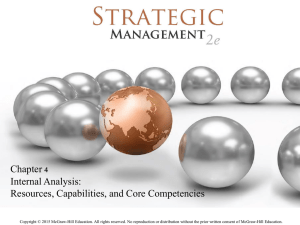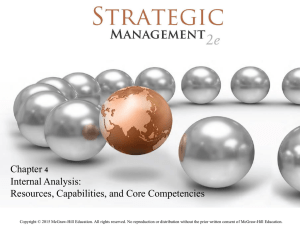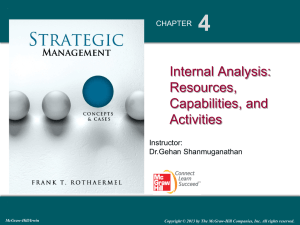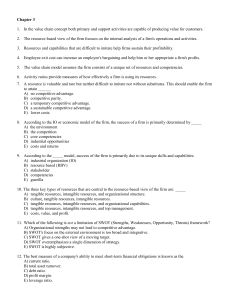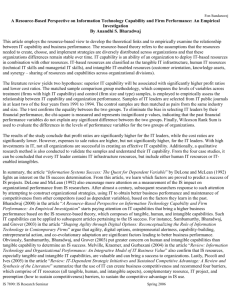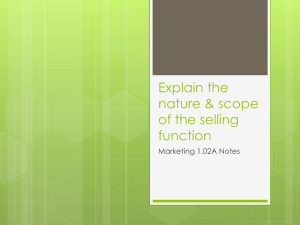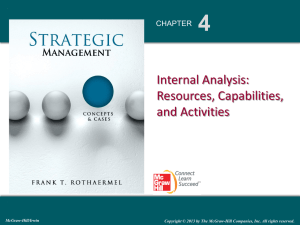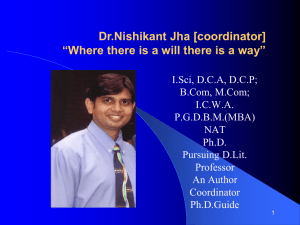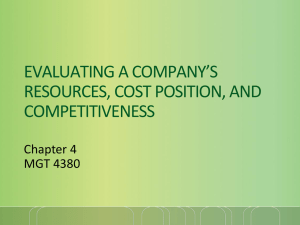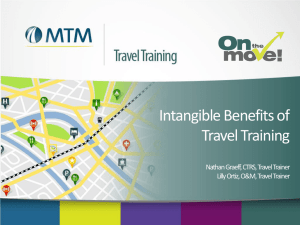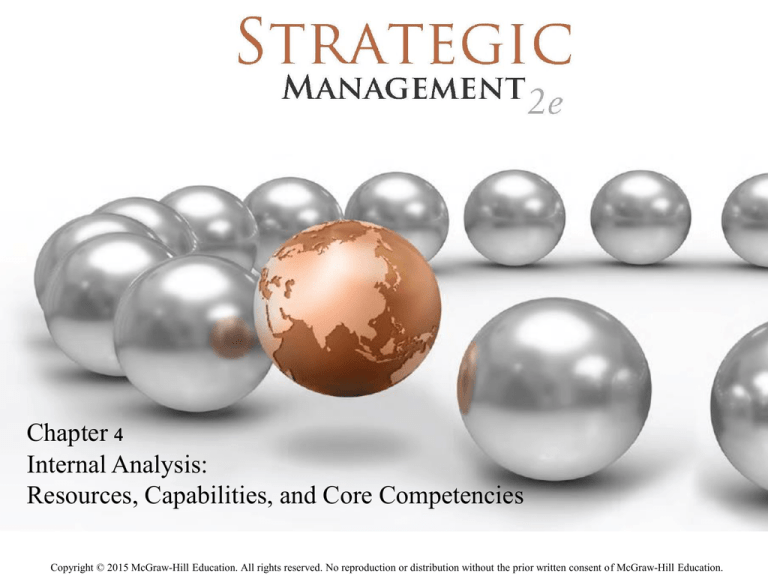
Chapter 4
Internal Analysis:
Resources, Capabilities, and Core Competencies
Copyright © 2015 McGraw-Hill Education. All rights reserved. No reproduction or distribution without the prior written consent of McGraw-Hill Education.
4-2
ChapterCase 4
Kobe Bryant
©Lucy Nicholson/Reuters/Landov
Nike’s Core Competency: The Risky Business of Fairy Tales
Nike, a company created by Bill Bowerman and Phil Knight in
1964, today has 60%−90% market share (depending on the
sport) and $25 billion in annual revenues.
These are sponsored celebrities epitomizing Nike’s core
competence of creating heroes, i.e., selecting athletes who
succeed against all odds.
This Core Competency does have its risks, as heroes do
sometimes fall, resulting in public relations disasters.
4-3
4.1 Looking Inside the Firm for
Core Competencies
Competitive advantage derives from core competencies,
which enable:
• Differentiation of products/services creating perceived
value, or
• Cost leadership – offering products/services of comparable
value at lower cost
NIKE – Core Competence – Just Do It
• Unlocking human potential
• Anyone can be a hero
4-4
Exhibit 4.2
Looking Inside the Firm for
Competitive Advantage, Resources, Capabilities,
Core Competencies, and Activities
4-5
Exhibit 4.4 Linking Resources, Capabilities,
Core Competencies, and Activities to Competitive
Advantage and Superior Firm Performance
4-6
RESOURCE CATEGORIES
Tangible Resources- Resources that have physical
substance and presence, easy to move and transfer from
one place to another
Examples of tangible resource include: Financial resources, Physical
resources (land, plant & equipment), Product resources, Cultural Artifacts
(Auburn Creed, Policy manuals, Logos)
Intangible Resources- Resources with no physical
substance or form, difficult to move or transfer from one
place to another
Examples of intangible resources include: Individual KSAs, Intellectual
Capital, Trust & Social Capital, Reputation, Organizational Culture
7
4-7
4.2 The Resource-Based View
Resource Value Calculation
Market Value = Sum of Tangible & Intangible
Resources
Book Value = Value of Firm Tangible Resources
Value of Intangible Resources = Market Value minus
Book Value
4-8
4.2 The Resource-Based View
Competitive advantage is more likely to develop
from intangible rather than tangible resources..
Tangible and Intangible Resources – Examples:
Apple
• Tangible Resource Value: $15 Billion
• Intangible Resource Value: $180 Billion
Google
• Tangible Resource Value: $8 Billion
• Intangible Resource Value: $110 Billion
4-9
Two Critical Assumptions
The two assumptions – that firms may control – are
critical in explaining superior firm performance for the
resource-based model:
1. Resource Heterogeneity
• Model assumption that a firm is a bundle of resources and
capabilities differ across firms
2. Resource Immobility
• Model assumption that a firm has resources that tend to be
“sticky” and that do not move easily from firm to firm
• Resource Endowments, Historical Context, Casual
Ambiguity, Social Complexity
4-10
The VRIO Framework
Valuable
• Attractive features
• Lower costs (& price)
Higher profits
• Honda – design & build
engines
Rare
• Only a few firms
possess
• Toyota – lean
manufacturing
Temporary competitive
advantage
Imitation/Substitute
• Unable to develop or
buy at a reasonable price
• Nike – Yes
• Crocs - No
Organizational
Complementary
Capabilities
• Exploit competitive
potential
Structure
Coordinating systems
• Xerox PARC – No
4-11
Strategy Highlight 4.1
Applying VRIO: The Rise and Fall of Groupon
Mason’s Strategic Vision for Groupon Was
To Be the Global Leader in Local Commerce:
2008 – 27-year-old Andrew Mason founded Groupon
Groupon creates marketplaces, i.e., a group-coupon
Internal Analysis – VRIO framework application would
have predicted Groupon’s first mover competitive
advantage as temporary at best.
External Analysis – The five forces model would have
predicted low industry profit potential.
4-12
HOW TO SUSTAIN A
COMPETITIVE ADVANTAGE
SUMMARY
Taken together, a firm may be able to protect its
competitive advantage – even for long periods of time –
when its managers have consistently:
1. Better expectations about the future value of resources
2. Have accumulated a resource advantage that can be
imitated only over long periods of time
3. When the source of their competitive advantage is
causally ambiguous or socially complex
4-13
Strategy Highlight 4.2
Bill “Lucky” Gates
Bill Gates is one of the richest people in the world.
He is also “rich” in LUCK.
In 8th grade his school got a computer and software programs.
In 1975 founded Microsoft with long-time friend Paul Allen.
In 1980 his mother heard IBM was looking for an operating
system…
Bill Gates didn’t have one, but he knew where to get one.
He then sold copies of MS-DOS to IBM (through a non-exclusive license),
and thus kept the copyright.
4-14
4.3 The Dynamic Capabilities
Perspective
A firm’s ability to create, deploy, modify, reconfigure,
upgrade, or leverage its resources in its quest for
competitive advantage
Essential to create a sustained competitive advantage
• A dynamic fit between internal strengths and external
opportunities
Resource stocks – current level of intangible
resources
Resource flows – investments to maintain or build a
resource
4-15
Exhibit 4.7 The Bathtub Metaphor:
The Role of Inflows and Outflows in Building
Stocks of Intangible Resources
4-16
4.4 The Value Chain Analysis
The internal activities a firm engages in when
transforming inputs into outputs
Each activity adds incremental value and associated
costs.
This concept can be applied to any firm – goods or
service.
The value chain helps to assess which parts add
value and which do not.
4-17
Exhibit 4.8 A Generic Value Chain:
Primary and Support Activities
4-18
Value Chain Activities
Link to generic strategies (add
features/control costs)
Redefine Value Chain activities
(create/add, eliminate/decrease)
Restructure/reorganize Value Chain flows
Internalize (backward & forward
integration) or externalize (outsourcing)
key activities
4-19
4.5 Implications for the Strategist
USING SWOT ANALYSIS TO COMBINE EXTERNAL
AND INTERNAL ANALYSIS
Synthesizes internal analysis of the company’s
strengths and weaknesses (S and W) with those from
an analysis of external opportunities and threats
(O and T)
SWOT =
•
•
•
•
VRIO Framework
Value Chain Analysis
PEST (PESTEL) Analysis
Porter’s 5 Forces Analysis
4-20
TOWS Matrix
4-21
TOWS Matrix
SO Strategies
• Strategies that enable competitive
advantage, external opportunities
match well with internal strengths,
allows for competitive advantage to
be built and maintained.
4-22
TOWS Matrix
ST Strategies
• Mitigation Strategies, firm possesses
internal strengths that facilitates
neutralization of external threats,
may lead to temporary advantage if
competitors are impacted by
environmental threats.
4-23
TOWS Matrix
WO Strategies
• Acquisition/Development Strategies,
situation where strategies are
formulated to acquire or develop new
resources/capabilities to take
advantage of external opportunities.
4-24
TOWS Matrix
WT Strategies
• Consolidation/Exit Strategies, if firms
can’t find ways to convert
weaknesses to strengths via
acquisition/development, exit from
market is recommended.
4-25
Using SWOT Analysis to Combine
External and Internal Analysis
SWOT Limitations
SWOT analysis – widely used management tool
However, a strength can also be a weakness, and an
opportunity can also be a threat.
The answer is – it depends…
To be an effective management tool, the strategist must
conduct thorough external and internal analyses,
grounding these analyses in rigorous theoretical
frameworks, in order to derive a set of strategic options.
4-26
ChapterCase 4
Kobe Bryant
©Lucy Nicholson/Reuters/Landov
Consider This…
• Nike’s strategy of building its core competency by creating
heroes is not without risks.
• Time and time again Nike’s heroes have fallen from grace.
• Although Nike’s co-founder and chairman Phil Knight
declared that scandals surrounding its superstar endorsement
athletes are “part of the game,” too many of these public
relations disasters could damage the company’s brand and
lead to a loss of competitive advantage.
4-27

